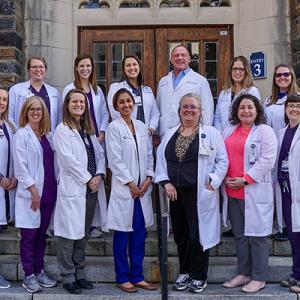Dr. Achanta Receives Society of Toxicology Awards
Congratulations to Satya Achanta, DVM, PhD, DABT, on earning the prestigious Donald E. Gardner Inhalation Toxicology Education and Outstanding Early Career Scientist awards, recognizing his contributions to the field of toxicology.
Duke Anesthesiology Ranks Top Three in the Nation Among Specialties
US News & World Report ranks Duke Anesthesiology third in the nation for “Best Medical Schools for Anesthesiology” and the Duke University School of Medicine sixth in the nation for “Best Medical Schools: Research” in its annual rankings.
Duke University Hospital Team Earns Prestigious Award
Congratulations to Duke’s Total Parental Nutrition (TPN)/Nutrition Support Team, led by Duke Anesthesiology’s Dr. Paul Wischmeyer, on being awarded the prestigious American Society for Parenteral and Enteral Nutrition Clinical Nutrition Team of Distinction Award.
Duke Anesthesiology Ranks Among Top 10 in NIH Funding
The Blue Ridge Institute for Medical Research ranks Duke Anesthesiology eighth in the nation for National Institutes of Health funding ($7.9 million) among anesthesiology clinical science departments.
No Link Between Cognitive Changes, Alzheimer’s Markers After Major Surgery
A newly-published study with first author, Dr. Miles Berger, could help ease concerns that Alzheimer’s disease risk might be increased by major surgeries and/or general anesthesia.
Dr. Yang Awarded Grant to Study Immunosuppression Phenomenon
Congratulations to Wei Yang, PhD, FAHA, on receiving a $1,619,689 R01 grant from the National Institutes of Health for his project aimed at advancing post-resuscitation care and improving overall cardiac arrest prognoses.
Dr. Treggiari Appointed Vice Chair for Research
Congratulations to Miriam M. Treggiari, MD, PhD, MPH, of Yale University, on being named the department’s vice chair for research in which she will develop an interdisciplinary strategy and lead efforts to grow, promote, and support research and scholarship of programs.
Dr. Yang Awarded R01 Grant for Ischemic Stroke Research
Congratulations to Wei Yang, PhD, on being awarded a five-year, $2,012,500 renewal grant from the National Institutes of Health to further study the role of the unfolded protein response in stroke outcomes.
New CRU Leadership Roles Announced
Congratulations to Drs. Kamrouz Ghadimi and Anne Cherry on being named the director and assistant director of the department’s Clinical Research Unit in which they will oversee the unit’s protocols and provide an innovative approach to the conduct of research.
Dr. Martucci Named a Research Incubator Award Recipient
Congratulations to Katherine Martucci, PhD, on receiving a 2022 Research Incubator Award from the Duke Institute for Brain Sciences to study how opioid medications change brain activity in patients with chronic pain.









